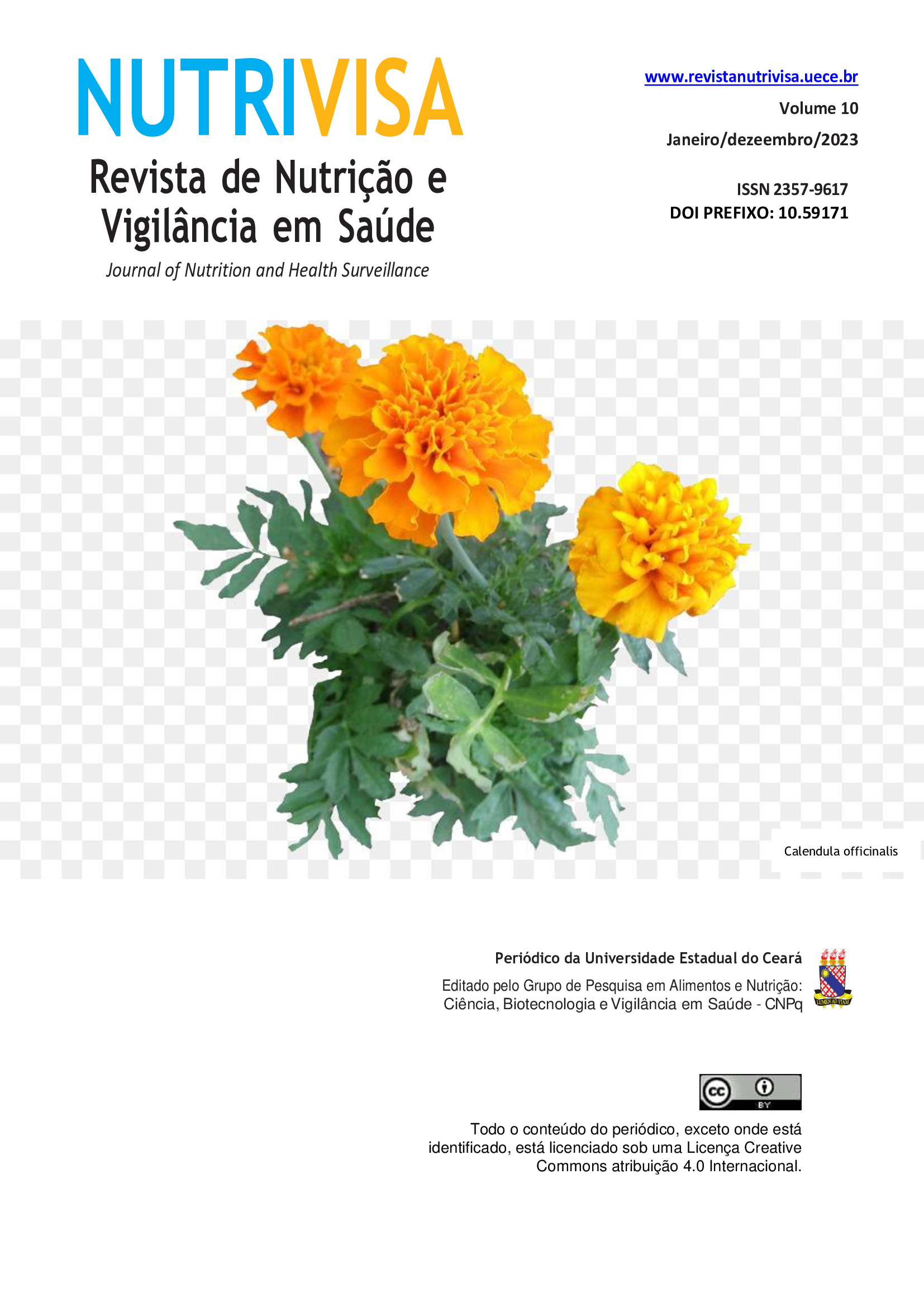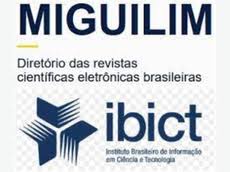Influência do tratamento térmico frente aos compostos antinutricionais em feijão-caupi
DOI:
https://doi.org/10.59171/nutrivisa-2023v10e10227Palavras-chave:
aquecimento, antinutrientes, grãos, revisãoResumo
O feijão-caupi é uma leguminosa de importância econômica e nutricional, sendo uma fonte barata de proteína para população nos países em desenvolvimento. No entanto, a presença de fatores antinutricionais influência na biodisponibilidade dos nutrientes. O processamento térmico leva a redução desses fatores. O objetivo deste trabalho foi verificar a influência dos tratamentos térmicos nos teores antinutricionais presentes no feijão-caupi. Trata-se de uma revisão integrativa com busca de dados científicos em bases indexadas, Web of Science, Scopus, Scielo, e Portal de Periódicos da Capes, com os descritores combinados: “heat treatment” and “antinutritional factors” and “cowpea”. Dos 245 artigos encontrados, 11 foram selecionados para compor os resultados, onde 10 avaliaram os inibidores de tripsina, 8 o teor de taninos, 8 o ácido fítico, 3 os oligossacarídeos, 3 o cianeto de hidrogênio, 2 os polifenóis e 2 as hemaglutininas. O cozimento foi o processo mais utilizado, seguido da autoclavagem, vapor de água, torração, cozimento sobre pressão, fritura e extrusão. Em 9 trabalhos houve redução significativa dos antinutricionais e em 2 a eliminação completa, sendo o tratamento térmico úmido o mais eficaz. Os efeitos dos tratamentos térmicos sobre estes compostos podem variar conforme a cultivar, teor de antinutrientes, tipo de processamento e tempo de exposição.
Referências
AKINYELE, I.O. Effects of traditional methods of processing on the nutrient content and some antinutritional factors in cowpeas (Vigna unguiculata). Food Chemistry, v.33, n.4, p.291-299, 1989. doi: https://doi.org/10.1016/S0308-8146(96)00212-9.
ANJOS, F dos.; VAZQUEZ-ANON, M.; DIERENFELD, E.S.; PSRSONS, C.M.; CHIMONIO, M. Chemical composition, amino acid digestibility, and true metabolizable energy of cowpeas as affected by roasting and extrusion processing treatments using the cecectomized rooster assay. Journal of Applied Poultry Research, v.25, n.1, p.85-94, 2016. doi: https://doi.org/10.3382/japr/pfv069.
AVANZA, M.; ACEVEDO, B.; CHAVES, M.; AÑÓN, M. Nutritional and anti- nutritional components of four cowpea varieties under thermal treatments: Principal component analysis. Food Science and Technology, v.51, n.1, p.148-157, 2013. doi: https://doi.org/10.1016/j.lwt.2012.09.010.
AYYAGARI, R.; RAO, B.S.N.; ROY, D.N. Lectins, trypsin inhibitors, BOAA and tannins in legumes and cereals and the effects of processing. Food chemistry. v.34, n.3, p.229-238, 1989. doi: https://doi.org/10.1016/S0308-8146(96)00212-9.
BENEVIDES C.M.J, SOUZA M.V, SOUZA R.D.B, LOPES M.V. Fatores antinutricionais em alimentos: revisão. Segurança Alimentar e Nutricional. v.18, n.2, p.67-79, 2011. doi: https://doi.org/10.20396/san.v18i2.8634679.
BEZERRA, J.M. Quantificação de compostos bioativos e capacidade antioxidante em cultivares de feijão-caupi. [Dissertação]. Pombal: Universidade Federal de Campina Grande, 2015.
BRASIL. Ministério da Agricultura, Pecuária e Abastecimento. Secretaria de Defesa Agropecuária. Regras para análise de sementes. Brasília: Mapa/ACS, 2009.
CAVALCANTE, R.B.M.; ARAÚJO, M.A.M.; ROCHA, M.M.; MOREIRA-ARAÚJO, R.S.R. Effect of thermal processing on chemical compositions, bioactive compounds, and antioxidant activities of cowpea cultivars. Revista Caatinga, v.30, n.4, p.1050-1058, 2017. doi: https://doi.org/10.1590/1983-21252017v30n426rc.
DEOL, J.K.; BAINS, K. Effect of household cooking methods on nutritional and anti-nutritional factors in green cowpea (Vigna unguiculata) pods. Journal of Food Science and Technology, v.47, n.5, p.579-581, 2010. doi: 10.1007/s13197-010-0112-3.
FROTA, K.D.M.G.; LOPES, L.A.R.; SILVA, I.C.V.; ARÊAS, J.A.G. Nutritional quality of the protein of Vigna unguiculata L. Walp and its protein isolate. Revista Ciência Agronômica, v.48, n.5, p. 792-798, 2017. doi: https://doi.org/10.5935/1806-6690.20170092.
GONÇALVES, A.; GOUFO, P.; BARROS, A.; DOMÍNGUEZ‐PERLES, R.; TRINDADE, H.; ROSA, E.A.S.; FERREIRA, L.; RODRIGUES, M. Cowpea (Vigna unguiculata L. Walp), a renewed multipurpose crop for a more sustainable agri‐food system: nutritional advantages and constraints. Journal of the Science of Food and Agriculture. v.96, n.9, p.2941-2951, 2016. doi: 10.1002/jsfa.7644.
JAICHAND, V.; DWARKA, D.; GERRANO, A.S.; MELLEM, J. Effect of heat processing on the nutritional and anti- nutritional factors of cowpea (Vigna unguiculata). In: The Annals of the University of Dunarea de Jos of Galati. Fascicle VI. Food Technology, v.44, n.1, p.165-177, 2020. doi:10.35219/foodtechnology.2020.1.10.
KALPANADEVI, V.; MOHAN, V.R. Effect of processing on antinutrients and in vitro protein digestibility of the underutilized legume, Vigna unguiculata (L.) Walp subsp. unguiculata. Food Science and Technology, v.51, n.2, p.455-461, 2013. doi: https://doi.org/10.1016/j.lwt.2012.09.030.
KATO, L.S. Caracterização química de feijão para produção de material de referência certificado [Dissertação]. Piracicaba: Centro de Energia Nuclear na Agricultura da Universidade de São Paulo, 2014.
LAURENA, A.C.; DEN, T.V.; MENDOZA, E.M.T. Effects of condensed tannins on the in vitro protein digestibility of cowpea [Vigna unguiculata (L.) Walp.]. Journal of Agricultural and Food Chemistry. v.32, n.5, p.1045-1048, 1984. doi: 10.1021/jf00125a025.
LONARDI, S.; MUÑOZ‐AMATRIAÍN, M.; LIANG, Q.; SHU, S.; WANAMAKER. S.I.; LO, S.; TANSKANEN, J.; SCHULMAN, A.H.; ZHU, T.; LUO, M.C.; ALHAKAMI, H. OUNIT, R.; HASAN, S.M.; VERDIER, J.; ROBERTS, P.A.; SANTOS, J.R.P.; NDEVE, A. DOLEŽEL, J.; VRÁNA, J., HOKIN, S.A.; FARMER, A.D.; CANNON. S.B.; CLOSE, T.J. The genome of cowpea (Vigna unguiculata [L.] Walp). The Plant Journal, v.98, n.5, p.767-782, 2019. doi: https://doi.org/10.1111/tpj.14349.
MELO, A.S.; SILVA, A.R.F.; DUTRA, A.F.; DUTRA, W.F.; BRITO, M.E.B.; SÁ, F.V.S. Photosynthetic efficiency and production of cowpea cultivars under deficit irrigation. Revista Ambiente & Água, v.13, n.5, p.2133, 2018. doi: https://doi.org/10.4136/ambi-agua.2133.
NIKMARAM, N.; LEONG, S.Y.; KOUBAA, M.; ZHU, Z.; BARBA, F.J.; GREINER, R.; OEY, I.; ROOHINEJAD, S. Effect of extrusion on the anti-nutritional factors of food products: An overview. Food Control, v.79, p.63–73, 2017. doi: https://doi.org/10.1016/j.foodcont.2017.03.027
OMENNA E.C.; OLANIPEKUN, O.T.; KOLADE, R.O. Effect of boiling, pressure cooking and germination on the nutritional and antinutrients content of cowpea (Vigna unguiculata). ISABB Journal Of And Agriculture Science. v.6, n.1, p.1–8, 2016. doi: 10.5897/ISABB-JFAS2016.0036.
RAKIĆ, S.; PETROVIĆ, S.; KUKIĆ, J.; JADRANIN, M.; TEŠEVIĆ, V.; POVRENOVIĆ, D.; ŠILER-MARINKOVIĆ, S. Influence of thermal treatment on phenolic compounds and antioxidant properties of oak acorns from Serbia. Food chemistry, v.104, n.2, p.830-834, 2007. doi: https://doi.org/10.1016/j.foodchem.2007.01.025.
SINGH, U. Antinutritional factors of chickpea and pigeonpea and their removal by processing. Plant Foods for Human Nutrition, v.38, n.3, p.251-261, 1988. doi: 10.1007/BF01092864.
SOUZA, C.G.; MOURA, A.K.B.; SILVA, J.N.P; SOARES, K.O.; SILVA, J.V.C; VASCONCELOS, P.V. Fatores anti-nutricionais de importância na nutrição animal: composição e função dos compostos secundários. PUBVET Medicina Veterinária e Zootecnia, v.13, n.5, p.1-19, 2019. doi: 10.31533/pubvet.v13n5a327.1-19.
TORRES, J.; PETERS, M.; MONTOY, C.A. Boiling influences the nutritional value of three seed cowpea (Vigna unguiculata) varieties using in vivo and in vitro methods. Food Chemistry, v.297, n.1, p.1-8, 2019. doi: https://doi.org/10.1016/j.foodchem.2019.06.007.
UDENSI, E.A.; EKWU, F.C.; ISINGUZO, J.N. Antinutrient factors of vegetable cowpea (Sesquipedalis) seeds during thermal processing. Pakistan Journal of Nutrition, v.6, n.2, p.194-197, 2007. doi: 10.3923/pjn.2007.194.197.
UMEDA, W.M. Caracterização nutricional, capacidade antioxidante e compostos bioativos de grãos de feijão (Phaseolus vulgaris L.) [Dissertação]. São José do Rio Preto: Universidade Estadual Paulista, 2017.
WANG, N.; LEWIS, M.J.; BRENNAN, J.G.; WESTBY, A. Effect of processing methods on nutrients and anti-nutritional factors in cowpea. Food chemistry, v.58, n.2, p.59-68, 1997. doi: https://doi.org/10.1016/S0308-8146(96)00212-9.
Downloads
Publicado
Como Citar
Edição
Seção
Licença
Copyright (c) 2023 Lisandra Maria da Silva Carvalho, Marcos Serra Luz, Lailton da Silva Freire, Maurisrael de Moura Rocha

Este trabalho está licenciado sob uma licença Creative Commons Attribution 4.0 International License.














